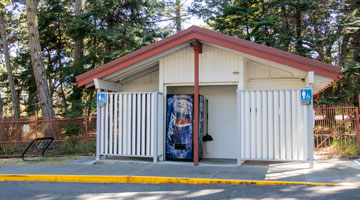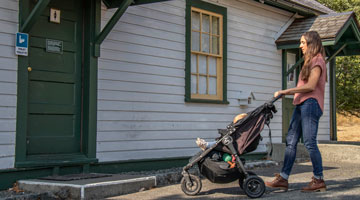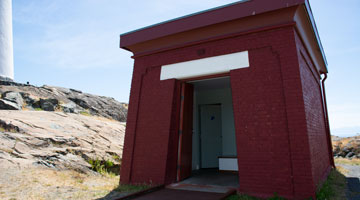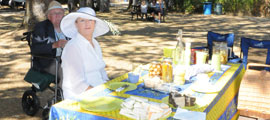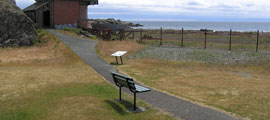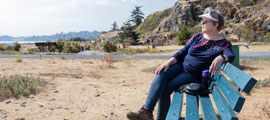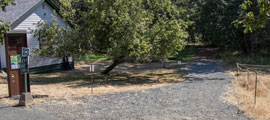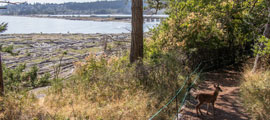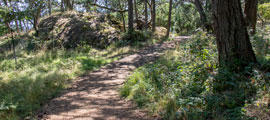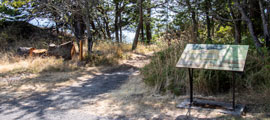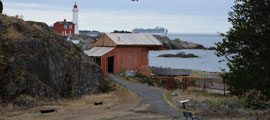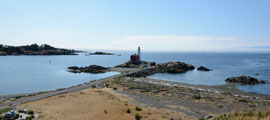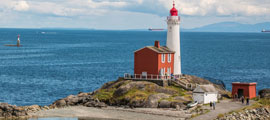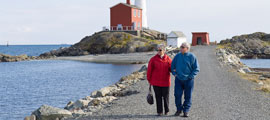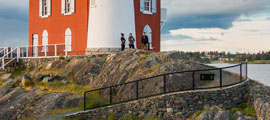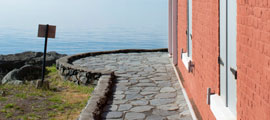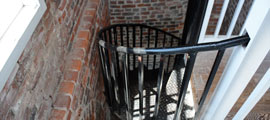
Accessibility
Fort Rodd Hill and Fisgard Lighthouse National Historic Sites
Current area closures of Fort Rodd Hill and Fisgard Lighthouse National Historic Sites.
For restoration purposes and/or safety reasons, these closures are clearly marked, and signage is posted.
These closures are:
- The washrooms located at the Second World War Officer’s Quarters.
- Washrooms in the main parking lot and by the lighthouse are available.
- The oTENTik camping experience is unavailable for the 2025 season.
Thank you for your patience and understanding.
Did you know
Accessibility Information
Tour through secret military bunkers, smell the flowers in the Garry Oak Learning Meadow, and feel the sea mist on your face as you head out to the lighthouse. Fort Rodd Hill and Fisgard Lighthouse National Historic Sites are updating trails, camping, facilities, and activities to make them as accessible as possible for a wide range of visitors with a variety of needs.
Here are a few of our more easily accessible travel highlights as well as some known barriers at Fort Rodd Hill and Fisgard Lighthouse National Historic Sites. Please contact us by phone (250-478-5849) or email (fortrodd@pc.gc.ca) if you would like to know more about accessible activities, trails, and overnight accommodation. We will be happy to help you plan your visit.
Accessible Amenities

Loose gravel or paved pathways bring you to many areas of the fort.
Designated accessible parking stalls
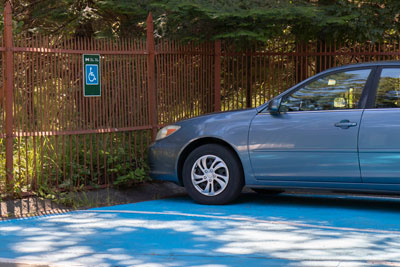
Four designated accessible parking stalls are available in the parking lot: two to the right of the Welcome Centre and washrooms, one directly across from those, and one next to the picnic benches near the anti-aircraft gun. A sidewalk ramp brings you from these parking stalls onto the sidewalk in front of the washrooms. Once on the sidewalk, you are about 20 m from the Welcome Centre. Alternatively, there is a curb cut directly in front of the Welcome Centre that is wide enough to accommodate most mobility aids and strollers. The accessible parking stalls do not have access aisles, and this can impede the use of vans with lifts when the lot is full.
Welcome Centre
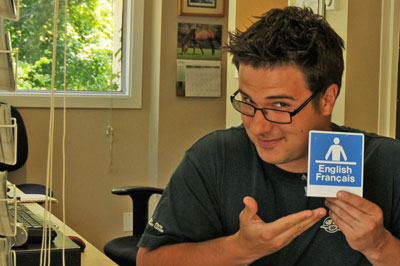
Regardless of how you plan to explore Fort Rodd Hill and Fisgard Lighthouse National Historic Sites, you will enter through the Welcome Centre. Here you will find the entry kiosk, site orientation, and an exhibit. Pay your entry fee, pick up a Site Guide, grab an Xplorer’s Booklet for the kids, rent an Audio Tour, and check out Parks Canada merchandise! The Welcome Centre is wheelchair accessible and has automatic door openers.
To find the Welcome Centre on the map of Fort Rodd Hill and Fisgard Lighthouse National Historic Sites, please visit the Fort Rodd Hill and Fisgard Lighthouse National Historic Sites Map.
Washrooms
Washrooms are indicated by a toilet icon on the site map, and accessible washrooms are indicated by a wheelchair symbol. Wheelchair-accessible washrooms are located near the Welcome Centre in the parking lot as well as at the lighthouse. The non-wheelchair-accessible washrooms located at the Second World War Officer’s Quarters are currently closed for renovations.
The washrooms at the lighthouse are gender-inclusive. They are fully enclosed, single-stall facilities offering you maximum privacy. For all washrooms, you are welcome to use the facility that best meets your identity and needs. Children’s change tables are available in the gender-inclusive washrooms at the lighthouse and in the women’s washrooms at the Second World War Officer's Quarters.
To find the washrooms on the map of Fort Rodd Hill and Fisgard Lighthouse National Historic Sites, please visit the Fort Rodd Hill and Fisgard Lighthouse National Historic Sites Map.
Manual wheelchair for day use
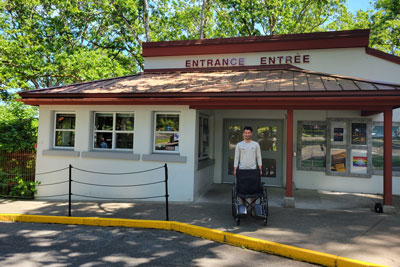
There is a folding, manual wheelchair available for day use. In some locations, the terrain may require someone to push it. When you arrive at Fort Rodd Hill and Fisgard Lighthouse National Historic Sites, you can ask to borrow the wheelchair from the Welcome Centre.
Rest and sheltered areas
Several indoor and outdoor benches and picnic tables are located throughout the site. To find shelter from the elements, step inside the Fortress Plotting Room, the Casemates Barracks, the Canteen and the Upper Battery Guardhouse. Picnic table locations vary but are easily visible; they are often located under the shade of a Garry oak tree.
Audio Tours
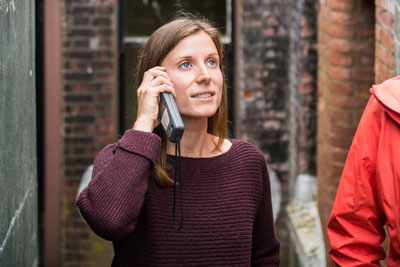
If you are looking for an immersive experience, try taking the Fort Rodd Hill and Fisgard Lighthouse National Historic Sites audio tour. Listen to bite-size tales of what life was like at the fort and the lighthouse throughout history. The audio devices are available from the Welcome Centre for a small fee. This tour is free for people with visual impairments and one person accompanying them. The audio tour is not a navigational tool and does not give you directions around the fort or lighthouse. If you are seeking a wayfinding tool, there is an audio-described tour available (more below).
For more information on the audio tour, please visit the Audio tour page. For the current cost of the audio tours, please visit the Fees page.
At the Ready: Accessible Guided Tour

Parks Canada aims to advance equity and inclusion by providing user-friendly information about site accessibility. At the Ready: an accessible guided tour provides a detailed overview of physical accessibility at the site. The tour describes steep slopes, uneven terrain, and other barriers that may prevent those using mobility devices or with limited mobility from accessing certain areas. The locations of rest areas, accessible washrooms, ramps, and wheelchair-friendly picnic tables are included in the information for each stop. Interpretive information is incorporated throughout to bring in a taste of the site’s history.
The tour is available for download for free on the Parks Canada app. Screen readers such as VoiceOver(iOS) and TalkBack(Android) are compatible with this tour. It is recommended that visitors download the tour in advance, if possible, so that it can be used without access to wifi or cellular data while on site.
For more information on the accessible guided tour, please visit: At the ready: an accessible guided tour.
Accessible activities
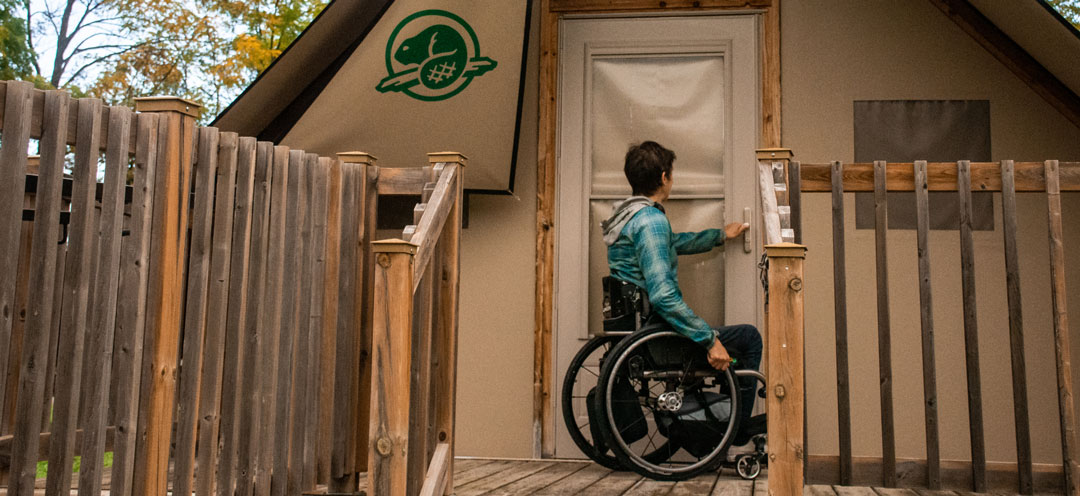
Several Parks Canada oTENTik welcome individuals with and without mobility restrictions.
The Canteen
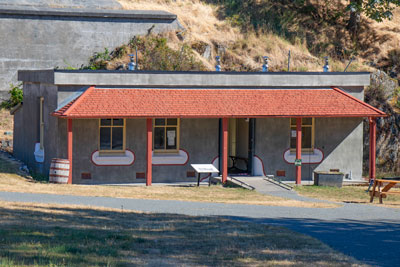
Visit the canteen for a taste of Fort Rodd Hill. Off-duty soldiers could enjoy a beer and a snack here. Pickled eggs and pigs’ feet were popular in the 1920s. In the summer, you can visit the Canteen to pick up a refreshing drink or cool down with heritage-themed ice cream. You can find several benches here. The Canteen is wheelchair accessible, with a ramp leading up to its doorway. There is a slight lip at the entrance.
To find the canteen on the map of Fort Rodd Hill and Fisgard Lighthouse National Historic Sites, visit the Fort Rodd Hill and Fisgard Lighthouse National Historic Sites Map.
The Garry Oak Learning Meadow
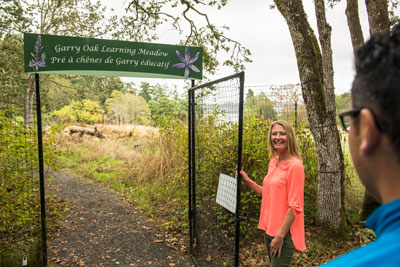
Need a break from the hustle-bustle of city life? Wind your way through the Garry Oak Learning Meadow. In the spring and summer, you will be welcomed by the smell of an ocean of blooming Camas Lilies and other native plants. This is one of the rarest ecosystems in Canada; a delicate landscape cultivated by the Lekwungen people, who grew Camas Lilies for their edible bulbs. Meet with a naturalist on location to learn some tips on growing rare native wildflowers and attracting bees and butterflies into your own garden naturescape.
The surface of the trail through the Garry Oak Learning Meadow is packed gravel and generally flat. Interpretive signs are located periodically along the pathways so you can learn more about the annual cycle of the Garry Oak ecosystem. In order to keep deer out of this protected meadow, there are manual gates with latches at both entrances to the Garry Oak Learning Meadow. Please close the door behind you when you enter or exit the meadow.
For more information on the Garry Oak Learning Meadow, visit the Garry Oak Learning Meadow section on the Nature and science page.
Lower Battery – Casemates Barracks
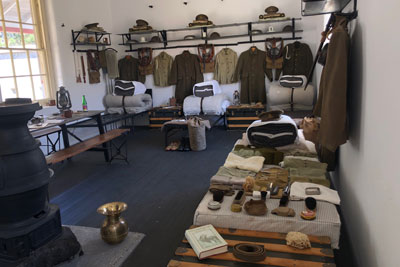
Holding up to 54 men in three large rooms, this enclosed barracks also had a parade square, washhouse, kitchen, a latrine, and separate oil, coal and food stores. Today you will find interactive exhibits, including a historic representation showcasing the soldiers’ items.
Head over to the Casemates Barracks if you want a quiet place to rest or shelter from the elements. There is both a temporary and permanent ramp for entry. Inside the barracks are wooden floors, and the pathways are either packed gravel or concrete. As with most other rooms at Fort Rodd Hill and Fisgard Lighthouse National Historic Sites, the heritage doors can be heavy and do not have automatic door openers.
Lower Battery – Fortress Plotting Room
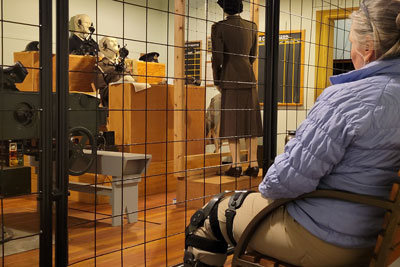
For a short period during the Second World War, the Fortress Plotting Room was the nerve centre of the Victoria-Esquimalt Fortress’s counter-bombardment guns. This calculation room worked with the forts at Mary Hill and Albert Head, and had no role in directing the guns at this site. In the 1950s, this room was an anti-aircraft plotting room, reflecting changing threats to Canadian sovereignty during the Cold War.
Visit the Fortress Plotting Room if you want a quiet place to rest or to shelter from the elements. There is a wooden ramp for entry and cement floors once inside. The heritage doors can be heavy and do not have an automatic door opener. They are left open for easier access.
Overnight oTENTik camping

Immerse yourself in all the site has to offer by booking a stay in one of the site’s five oTENTik cabins. These structures are a cross between a tent and an A-frame cabin, complete with a raised floor, beds, and a table and chairs. oTENTik #1 has a wheelchair ramp, a rollaway cot, and easy access to a wheelchair-friendly outdoor portable toilet. You can learn more about staying on site on our oTENTik page.
Accessible trails
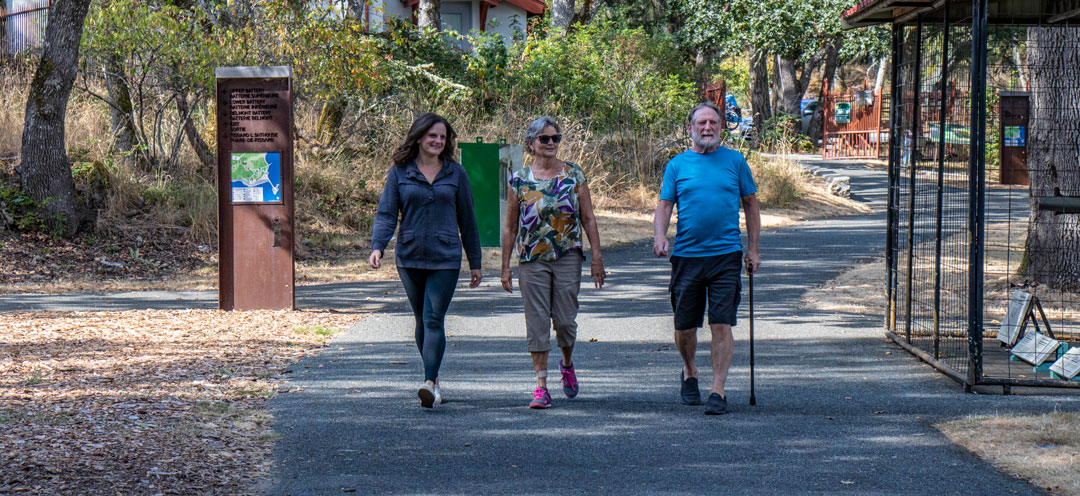
The paved pathways throughout the site are perfect for a gentle stroll.
Historic Nature Trail
The Historic Nature Trail is a meandering path that takes you from the Second World War Officers’ Quarters (just past the Garry Oak Learning Meadow) to the Belmont Battery. Along this trail, you will smell the moist undergrowth of moss, ferns, and other vegetation typical of the Garry oak forest ecosystem. You will be shaded by tree species such as Garry oak, Douglas fir, and arbutus.
It is recommended that this trail be experienced counter-clockwise, starting at the Second World War Officer’s Quarters. Doing so takes you gently downhill, with only one uphill section. However, you may travel the trail in either direction. The trail ranges from 1.8 m to 2.1 m (6 ft. to 7 ft.) wide and the narrowest portion is 1.1 m (3 ft. 6 in.) wide. The maximum grade of the Historic Nature Trail is 14 degrees. The surface of the trail consists of hard-packed dirt and moderately packed cedar chips; the ground can become soft in the winter or after a rainy day. Debris occasionally falls onto the path after a storm and there may be small roots or rocks along the path. Staff do their best to keep the trails clear of debris so you can enjoy a stroll in nature.
To find the Historic Nature Trail on the map of Fort Rodd Hill and Fisgard Lighthouse National Historic Sites, visit the Fort Rodd Hill and Fisgard Lighthouse National Historic Sites Map.
Beach Access
Head down to the three beaches near Fisgard Lighthouse to hear the waves crashing on the shore and look out for a lurking Harbour Seal, a massive sea lion, or maybe even the dorsal fin of a whale passing in the distance.
The first beach, which is the main one, is located below the cliffs of Lower Battery. There are two ways to approach the beach, either by taking the gravel path to the right of the causeway, or by taking a short path—partly gravel and partly paved—from Belmont Battery to the Searchlight Emplacement No. 7. However, access to the water may not be possible due to the soft sand and driftwood that washes up on the beach. Furthermore, the trails down to the beach might be challenging for some people because they can be bumpy and include emerging tree roots. Visitors may find it helpful to come with one or two other people to help them get down to the beach.
Once on the beach, there are some hard-packed sand and dirt areas close to the cliff that most wheelchairs, strollers, and other mobility aids can cross. Here you will get a close-up view of the searchlight boathouse, as well as the anti-torpedo nets and plenty of local flora.
The second beach is found to the left of the Causeway leading to the lighthouse. A sandy area with buildups of driftwood must be crossed to access the water.
The third beach is located at the foot of the lighthouse and the paved Causeway takes you there. This beach is mostly large pebbles with no driftwood.
Please be aware that debris washing up on the beach during storms and tides constantly changes the accessibility conditions of the beach.
To look at how to access the beaches on the map of Fort Rodd Hill and Fisgard Lighthouse National Historic Sites, visit the Fort Rodd Hill and Fisgard Lighthouse National Historic Sites Map.
Known barriers
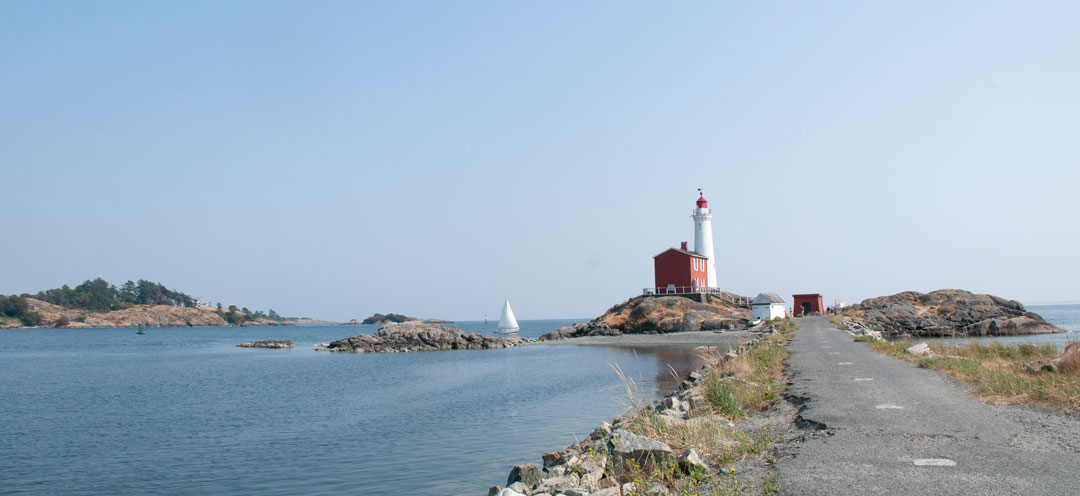
A Causeway connects the fort to the lighthouse.
Parks Canada employees are working hard to make Fort Rodd Hill and Fisgard Lighthouse National Historic Sites as accessible as possible. Please speak with us at the Welcome Centre, contact us by phone (250-478-5849), or send us an email (fortrodd@pc.gc.ca) if you want to discuss any of these barriers. We will be happy to help you plan your visit.
Because the buildings at Fort Rodd Hill and Fisgard Lighthouse National Historic Sites are protected as culturally significant locations, some areas are not universally accessible.
- There are few automatic door openers and some historic doors can be quite heavy.
- While the main paths are concrete, several smaller paths and courtyards are either loose gravel, packed gravel or dirt.
- Since this was a military fort, there are many rooms that are hidden underground, accessed only by a flight of stairs. There was a military advantage to gaining the high ground, so many features can also be found at the top of a flight of stairs or ladder.
- Several of the rooms or buildings that are on-grade have lips of up to 10 cm.
- Occasionally, there is a gun demonstration on the field beside the Garry Oak Learning Meadow or near Belmont Battery. This can be heard across the site and can be quite loud if you are nearby. The demonstration is always scheduled in advance. If you want to know if the gun will be firing during your visit, call in advance or ask at the Welcome Centre when you arrive.
- Some buildings have a special feature: you can get a “scent” of history. For example, the Engine Room smells like diesel, just like it would have while the engines were running. Be prepared for strong smells in locations identified on the site map with a nose icon.
- In the spring, algae are blooming, which can generate a foul smell during low tides. At times this smell can be noticeable while going across the Causeway and can be overwhelming, but once you get closer to the lighthouse, the smell dissipates.
Accessibility limitations at Fisgard Lighthouse
Named a national historic site in 1960, a century after first showing its light, Fisgard is still a working lighthouse—although the last keeper rowed away in 1929. Access to and visiting inside the lighthouse may be difficult for some visitors.
Although the path is paved, wear and tear from intense west coast storms has made it a bit bumpy in certain areas. Once across the Causeway, there are two ways to enter the lighthouse, either via a flight of short-rise stairs or up a coarsely paved ramp.
The curved ramp up to the lighthouse has a very steep section with a 27% slope (a standard ramp is 8.3%) and is 1.1 m (3 ft. 6 in.) at its narrowest point. Once at the top of the stairs or ramp, visitors will find a stonework pathway around the lighthouse. There is a cement block preventing a wheelchair or large stroller from going around the entire lighthouse. There are two entrances to the lighthouse. One has a 13 cm (5 in.) step to get inside, while the other has a 5 cm (2 in.) step. Wheelchair or stroller users may require assistance to cross these steps. At times, the entrance doors may be closed to keep the heat in; these doors are heavy, and assistance may be needed to open them.
Once inside the lighthouse, visitors can choose to remain on the main floor, or head upstairs. The main floor contains two rooms, interpretive signs that tell the stories of the lighthouse keepers, a stove exhibit, and many artifacts on the walls. The upper floor has a beautiful view of Esquimalt Harbour and games for people of all ages to play. There are two sets of stairs to reach the upper floor of the lighthouse, one of which is a spiral staircase and the other a straight staircase. If you are able to access the main floor but are unable or do not wish to visit the upper floor of the lighthouse, there is plenty to enjoy in the interpretive exhibit on the ground floor.
For more information on Fisgard Lighthouse, visit Fisgard Lighthouse, first lighthouse on the west coast of Canada or refer to the Did you know section below.
Did you know
Attractions Victoria has created three virtual tours showcasing some areas of Fort Rodd Hill and Fisgard Lighthouse National Historic Sites. You can virtually visit the site’s entrance and foyer, the Fortress Plotting Room, and Fisgard Lighthouse anytime. With this tool, you can assess ahead of time how to comfortably visit the sites and visually access information and exhibits that may be out of reach for you. Take a little peek before your next visit at Attractions Victoria.
- Date modified :
